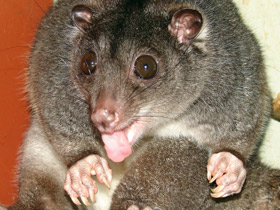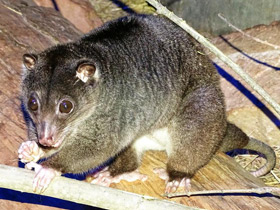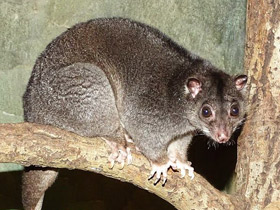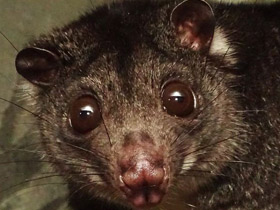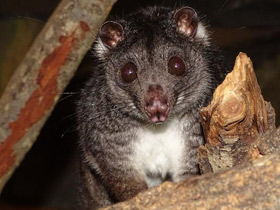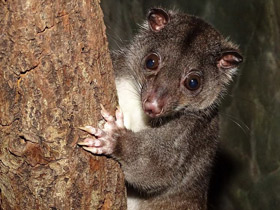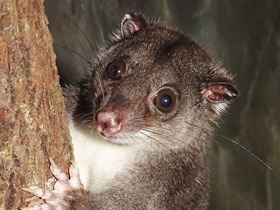The family Phalangeridae
The ground cuscus (Phalanger gymnotis)
The Phalangeridae are a family of mostly nocturnal marsupials native to Australia, New Guinea, and Eastern Indonesia, including the cuscuses, brushtail possums, and their close relatives. Considered a type of possum, most species are arboreal, and they inhabit a wide range of forest habitats from alpine woodland to eucalypt forest and tropical jungle. Many species have been introduced to various non-native habitats by humans for thousands of years.
Description
Phalangeridae are a family of nocturnal marsupials native to Australia and New Guinea, including the cuscuses (Ailurops, Phalanger, Spilocuscus and Strigocuscus), brush-tailed pósum and ilangnalia. They live in trees and their habitat is eucalyptus forests and jungles. The Phalangeridae comprise 6 genera including about 20 species. Phalangeridae have a dense build and small size (10-65 mm). The snout of Phalangeridae is short, the ears small and the eyes large. The grasping tail, as an adaptation to an arboreal lifestyle, is 24-61 cm long. The body is covered with soft, tight hairs of brown, grey, black, yellowish or white, often with spots or stripes.
Phalangeridae have limbs with five toes and claws. The claws help the animals to climb trees, where they spend most of their lives. Only the first toe, unlike the rest, lacks a claw (in some species the first and second toes). Its purpose is to grasp. The second and third toes of the hind feet are connected by a skin membrane.
Habitat and lifestyle
Phalangeridae inhabit forested areas of Australia, New Guinea, Tasmania, Kerama, Sulawesi, Timor, the Bismarck Archipelago, the Solomon Islands and other small islands. They spend most of their lives in trees, only occasionally descending to the ground (the exception is the Australian brushtail possum (Trichosurus vulpecula)).
Members of the family Phalangeridae have a nocturnal lifestyle, resting in hollows and bird nests during the day. Despite their sluggishness and sluggishness, they are excellent tree walkers. Phalangeridae are herbivorous animals. Their diet includes roots, fruits, leaves, rhizomes, etc. There are also omnivorous and insectivorous species. The life expectancy of Phalangeridae varies from 6 to 12 years depending on the size of the animal. Many species of this family are rare and protected.
Distribution
Phalanger is a genus of diprotodontid marsupials of the family Phalangeridae commonly known as cuscuses. They are distributed throughout the Wallacea and Australasia.
Some scientists suggest that the Phalanger originated in New Guinea and from there spread to neighbouring islands. Phalangers are now found in northern Australia (Cape York Peninsula), Sulawesi, Seram, Buru, New Guinea, Timor, the Solomon Islands, the Moluccas and the Bismarck Archipelago.
Classification
This classification is based on Beck et al. (2022). The listing for extant species is based on The Third edition of Wilson & Reeder's Mammal Species of the World (2005), except where the Mammal Diversity Database and IUCN agree on a change.
- Incertae sedis:
- †Eocuscus;
- †Eocuscus sarastamppi;
- †Onirocuscus;
- †Onirocuscus inversus;
- †Onirocuscus notialis;
- †Onirocuscus reidi;
- †Onirocuscus rupina;
- †Onirocuscus silvacultrix;
- †"Trichosurus" dicksoni;
- Subfamily Trichosurinae:
- †Archerus;
- †Archerus johntoniae;
- Trichosurus;
- Northern brushtail possum (Trichosurus arnhemensis);
- Short-eared possum (Trichosurus caninus);
- Mountain brushtail possum (Trichosurus cunninghami);
- †Trichosurus hamiltonensis;
- Coppery brushtail possum (Trichosurus johnstonii);
- Common brushtail possum (Trichosurus vulpecula);
- Wyulda;
- †Wyulda asherjoeli;
- Scaly-tailed possum (Wyulda squamicaudata);
- Subfamily Ailuropinae:
- Ailurops;
- Talaud bear cuscus (Ailurops melanotis);
- Sulawesi bear cuscus (Ailurops ursinus);
- Subfamily Strigocuscus;
- Sulawesi dwarf cuscus (Strigocuscus celebensis);
- Banggai cuscus (Strigocuscus pelegensis);
- Subfamily Phalangerinae:
- Phalanger;
- Gebe cuscus (Phalanger alexandrae);
- Mountain cuscus (Phalanger carmelitae);
- Ground cuscus (Phalanger gymnotis);
- Eastern common cuscus (Phalanger intercastellanus);
- Woodlark cuscus (Phalanger lullulae);
- Blue-eyed cuscus (Phalanger matabiru);
- Telefomin cuscus (Phalanger matanim);
- Southern common cuscus (Phalanger mimicus);
- Northern common cuscus (Phalanger orientalis);
- Ornate cuscus (Phalanger ornatus);
- Rothschild's cuscus (Phalanger rothschildi);
- Silky cuscus (Phalanger sericeus);
- Stein's cuscus (Phalanger vestitus);
- Spilocuscus;
- Admiralty Island cuscus (Spilocuscus kraemeri);
- Common spotted cuscus (Spilocuscus maculatus);
- Waigeou cuscus (Spilocuscus papuensis);
- Black-spotted cuscus (Spilocuscus rufoniger);
- Blue-eyed spotted cuscus (Spilocuscus wilsoni).
The ground cuscus (Phalanger gymnotis)
The ground cuscus (Phalanger gymnotis) is a marsupial from the order Diprotodontia and belongs within the family Phalangeridae, a diverse family consisting of the other cuscus species and the brushtail possums (Trichosurus spp.) and the scaly-tailed possum (Wyulda squamicaudata).
Names
It is known as madaw, ket-ketm, or kñm in the Kalam language of Papua New Guinea.
Habitat and nutrition
Phalanger gymnotis is a marsupial species of the family Phalangeridae, which inhabits New Guinea and the Aru Islands between 200 and 2600 m altitude. As an arboreal species, Phalanger gymnotis prefers dense forests at altitudes up to 1600 m, where it spends most of the day. Nestled in a hollow or in dense vegetation, Phalanger gymnotis sleeps until late afternoon to conserve energy; at night it comes out to feed. Phalanger gymnotis prefer to feed on leaves, fruits, shoots, flowers, eggs and insectivores. These small animals can also be found in gardens.
Appearance
The Phalanger gymnotis is a robust animal, measuring between 25 and 65 cm in length, depending on species and sex, and can weigh between 5 and 7 kg as an adult. Their tail is grasping and helps them to hold on to trees and move around, and its length is almost equal to the length of their body. The tail is covered with coarse bristles instead of hairs.
The fur of Phalanger gymnotis is fluffy but coarse. Sexual dimorphism is evident: males and females differ not only in size, but also in colouring. Females are red-brown or grey-brown and have a white thorax and tail. Males have a white body and tail and sometimes grey in different shades. The chest glands are yellowish. Males also have a black longitudinal stripe on the back. Phalanger gymnotis acquires this colouration as it matures, while juveniles have the same colouration as the female.
Phalanger gymnotis is also characterised by: 1st and 2nd opposable toes, claws on all toes, uncovered soles of feet, large eyes and flat snout. They have 34 to 40 teeth, with small canines closely attached to the incisors.
Breeding
Breeding of Phalanger gymnotis is not scheduled to a specific period, but peaks in June-October. After a short gestation of up to 13 days, the female gives birth to 1-3 young, of which usually only one survives.
Lifespan
No information on longevity in the wild is available. A captive specimen was known to live for 18 years with 10 years not uncommon.

















